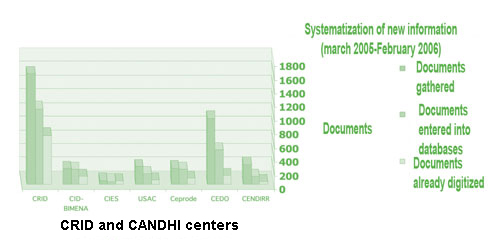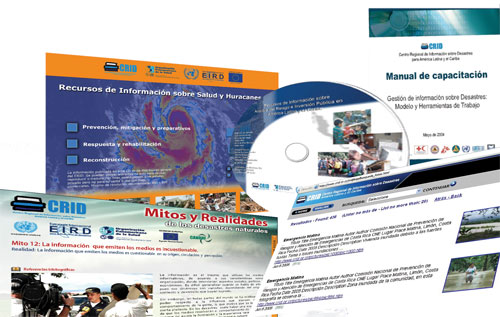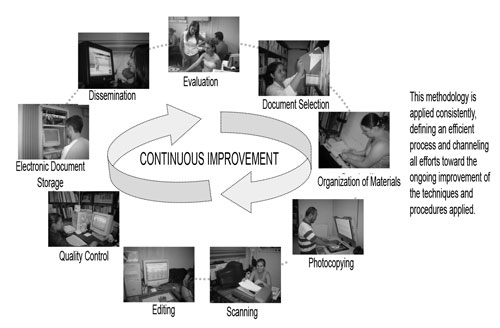Information
center’s user and the new age of knowledge
management
Information is essential for good risk reduction management. In 1997,
in response to the needs expressed by Latin American and Caribbean governments
and civil institutions, six organizations decided to establish the Regional
Disaster Information Center (CRID by its Spanish acronym). The goal of
the Center is to contribute to the development of a culture of prevention
in Latin America and the Caribbean, by providing information on disasters
and promoting collaborative efforts to improve risk management in the
region.

The use of new technologies has facilitated the information transfer
and communication services involved in this work, allowing CRID to diversify
its products and services and expand its area of action.
Currently, CRID offers services and products that include the access
to more than 16,000 bibliographical records and audiovisual materials
related to the topic of disasters; assistance to a wide range of users
as they search for and locate information on disasters in both physical
and electronic media; the publication and distribution of specialized
bibliographies; technical assistance and training on information management
for different information centers; and electronic access to a collection
of more than 10,000 full-text documents and photo-graphic materials.

Digitizing Documents
Early history
In early 2002, with the financial support of the United States National
Library of Medicine (NLM), the Pan-American Health Organization (PAHO)
and the UN/ International Strategy for Disaster Reduction (ISDR), CRID
launched a project aimed at improving access to information on health
and disasters in Central America. As a result of this initiative, a
process of digitizing full-text documents was implemented, and the
Central American Network for Disaster and Health Information (CANDHI)
was created.
Project consolidation
In 2005, the European Commission’s Humanitarian Aid Office (ECHO)
decided to support this project financially so that the CANDHI network
could be used to improve the existing information management capacity
related to disasters in Central America.
The strategy consisted mainly
of giving these centers the knowledge, training and technological resources
needed to carry out activities that
would facilitate the distribution and exchange of technical information
in the Central American region. This included converting paper documents
into electronic form, or “digitizing” them.
Digitizing process
The process begins by selecting materials to be digitized and preparing
them to be scanned (material is selected according to criteria established
by information management specialists). The physical characteristics
of the documents are evaluated, respecting their defined structure
(chapter, sections and parts). In some cases where the binding makes
scanning difficult, the documents are photocopied before being scanned.

Subsequently, the actual scanning occurs and the electronic image is
captured in two different formats: TIF (Tagged Image File Format), which
allows the information to be saved in a standard high-quality format
that can be converted easily into other formats commonly used in electronic
information exchange; and PDF (Portable Document Format), which can be
used in electronic media, such as the Internet.
Each page of the document is edited using various techniques that improve
the image and eliminate anything that is extraneous to the content or
that reduces the quality of the document, like shadows, dots, stains,
dark borders etc.
In order to facilitate access to the electronic document, an HTML (Hypertext
Markup Language) page is created in which the user can click on links
to access content-specific material. Finally, the document is given an
overall inspection to make sure it conforms to specific quality control
standards for accessibility, appearance, and faithfulness to the original
document. The digitized documents are published on the CRID website (www.crid.or.cr/digitalizacion)
and are ready for our users to access them.
More than 10,000 documents (a little more than half a million pages)
have passed through this simple and practical process, which has yielded
excellent results. Approximately 200 new full-text documents are published
each month on our website.
Achievements and benefits obtained
- Distribute
information to more users in an orderly way.
- Offer a decentralized
service; information gets to the user quickly
and easily through the Internet and other electronic media.
- Reduce
response time and mailing costs considerably, since documents
no longer have to be
photocopied and sent by mail.
- Guarantee
the durability and permanence of documents over time.
- Create
information products with value added.
- Transfer
digitization knowledge and practices, not only to those centers
participating in
the CANDHI network, but also to other institutions
in the region interested in this initiative.
- Other
services and products based on document digitization.
- CDs on
various topics: CRID will create a series of interactive CDs that
will help expand
its services using an electronic means other
than the Internet. This CD series has an average of 100 full-text documents
on topics such as early warning, human settlements, avian flu, health
and hurricanes, myths and realities of natural disasters, and many others.
Information on the CDs can be retrieved by subtopic or through a user-friendly
internal search engine. Each CD also has a website section for users
to visit, and a contact list of people and institutions who are specialists
in this field.
- Photographic
material: Based on the methodology used in document processing,
a new service
has recently been created for digitizing photographic
material so that users have more quality material at their disposal related
to health and disasters.
- Audiovisual
material: Soon, a collection of audiovisual material will also
be digitized,
converting them from analog forms like VHS to
DVD formats.
Transfer of knowledge
The experience acquired has led other organizations and institutions
interested in improving their information services to seek out our organization
for training sessions on the subject. These organizations and training
sessions include:
- CLAMED
(Latin American Center for Disaster Medicine) in Havana, July 2006.
- INDECI-MINSA
(Peruvian National Institute of Civil Defense- Peruvian Ministry
of Health) in
Lima, December 2005.
- CNE (Costa
Rican National Emergency Commission) in San José,
November 2005.
- CANDHI
network (Central American Network for Disaster and Health Information)
in San Salvador,
November 2005.
- CEPRODE
(Disaster Protection Center) in San José,
October 2005.
- CEDO-CNE
(Documentation Center of the Costa Rican National Emergency Commission)
in San José, October 2005.
- CENDIRR (National
Center for Documentation and Information for Risk Reduction in Panama)
in San José,
October 2005.
- IFRC (International
Federation of Red Cross and Red Crescent Societies) in Panama City,
September 2005.
- CANDHI Network (Central
American Network for Health and Disaster Information) in Panama City,
May 2005.
- PAHO (Pan-American
Health Organization, Andean Region, Cuba, Costa Rica and Chile)
in Lima, November 2004.
- INDECI
(National Civil Defense Institute of Peru), in Lima, November 2004.
- CANDHI
(Central American Network for Disaster and Health Information), in
Guatemala City, February
2004.
CRID has provided ongoing support to each of the documentation centers
that constitute CANDHI network, not only by offering training sessions
on the methodology developed by the technical team, but also by providing
support for their digitization processes via email, phone, and online
consultations of a manual detailing all of these experiences. In addition,
every month, CRID sends approximately 250 newly digitized documents to
network centers, in order to strengthen access to information on disasters
in each country.
Digitization in Project Management
The digitization of documents has been an important part of project
management for organizations and institutions at all levels, especially
those that work on the issue of risk reduction. Among the documents converted
into electronic form are:
- CD: “Disaster
Risk Reduction 1994-2004”.
International Strategy for Disaster Reduction (ISDR/UN).
- CD: Information
on Risk Management in Costa Rica. Costa Rican National Emergency
Commission
(CNE).
- CD: “Early
Warning in Perspective: Compilation o f Cases, Experiences and Lessons
Learned.” German Agency for Technical Cooperation
(GTZ).
- CD with
information sources on related topics: training for strengthening
local capacity
in disaster management. Japanese International
Cooperation Agency (JICA).
- CD: Analysis
of vulnerabilities and capacities in community education projects.
CRREC (Regional Reference
Center on Community Education
for Disaster Prevention).
- CD with
information sources on seismology, education, and related topics,
prepared for the VIII Venezuelan Congress on Seismology and Seismic
Engineering “Education, an Essential Element in the Prevention
of Natural Disasters,” held in Valencia, Venezuela, May 17-19,
2006, in the School of Civil Engineering, Department of Engineering,
of the University of Carabobo.
CRID has also developed additional
services, including the adaptation of educational material to virtual
environments, as part of its strategy
for growth and positioning within the international market. One example
is the interactive material included in the series of modules titled “…Es
mejor prevenir” [...Prevention is better], developed by the Regional
Reference Center for Community Education on Risk Reduction (CRREC) of
the IFRC (International Federation of Red Cross and the Red Crescent
Societies).
For further information about the digitization process, contact:
The Regional Disaster Information Center (CRID)
P.O. Box 3745-1000 San José, Costa Rica
digitalizacion@crid.or.cr
www.crid.or.cr
|




